Documents: Go to download!
- Owner's manual - (English)
User manual of Kenmore 79575549401 (35 pages)
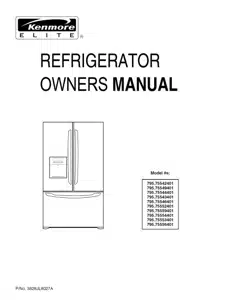
User Gudie Kenmore 79575543401 Elite Refrigerator
Table of contents
- French Version
- Warranty (U.S.A.)
- Protection Agreements
- Safety Instructions 4-
- Grounding Requirements
- Parts and Features
- Refrigerator Installation 7-
- Unpacking Your Refrigerator
- Installation
- Removing and Replacing
- Your Refrigerator Handles
- Doors 8-
- Leveling and Door Alignment
- Base Cover
- Using Your Refrigerator 14-
- Ensuring Proper Air Circulation
- Multi-Flow
- Setting the Controls
- Adjusting Control Settings
- Food Storage Guide
- Storing Frozen Food
- Refrigerator Features
- Water Dispenser
- Refrigerator Shelves
- Wine Holder
- Suprafresh Crispers with -lilt-out Compartment
- Crisper Humidity Control
- Crisper with Tilt-out Feature
- Removing Crisper 18-
- Crisper Cover with Lattice on inner
- Surface
- Glide N Serve
- Modular Door Bins
- Dairy Bin
- Egg Box
- Freezer Features
- Tilting Door
- Ice Bin
- Tilt-Out Door Basket
- Durabase
- Durabase Divider
- Pull out Drawer
- Water Filter
- Care and Cleaning 24-
- General Cleaning Tips
- Outside
- Inside Walls
- Door Liner and Gaskets
- Plastic Parts
- Condenser Coils
- Light Bulb Replacement 24-
- Power Interruptions
- When you go on vacation
- When you move
- About the Automatic Icemaker
- Connecting the Water Line 27-
- Troubleshooting Guide
SAVE THESE INSTRUCTIONS
- Child entrapment and suffocation are not problems of the past. Junked or abandoned refrigerators are still dangerous even if they will sit for just a few days.
- If you are getting rid of your old refrigerator. please follow the instructions at right to help prevent accidents.
BEFORE YOU THROW AWAY YOUR OLD REFRIGERATOR OR FREEZER
- Take off the doors.
- Leave the shelves in place so that children may not easily climb inside.
- Your old refrigerator may have a cooling system that used CFCs (chlorofuorocarbons).
- CFCs are believed to harm stratospheric ozone.
- If you are throwing away your old refrigerator. make sure the CFC refrigerant is removed for proper disposal by a qualified servicer. If you intentionally release this CFC refrigerant. you can be subject to fines and imprisonment under provisions of environmental legislation.
TO CONNECT ELECTRICITY
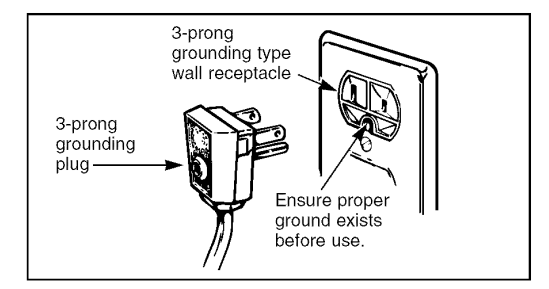
- The refrigerator should always be plugged into its own individual properly grounded electrical outlet rated for
- Volts, 60 Hz, AC only, and fused at 15 or 20 amperes.
- This provides the best performance and also prevents overloading house wiring circuits which could cause a fire hazard from overheated wires. It is recommended that a separate circuit serving only this appliance be provided.
- Use a receptacle which cannot be turned off with a switch or pull chain. Do not use an extension cord.
- Where a standard two-prong wall outlet is encountered, it is your personal responsibility and obligation to have it replaced with a properly grounded three-prong wall outlet.
- Do not, under any circumstances, cut or remove the third (ground) prong from the power cord.
NOTE:
- Before performing any type of installation, cleaning, or removing a light bulb, turn the control
- Thermostat, Refrigerator Control or Freezer Control, depending on the model) to OFF and then disconnect the refrigerator from the electrical source.
- When you are finished, reconnect the refrigerator to the electrical source and reset the control (Thermostat, Refrigerator Control or
- Freezer Control, depending on the model) to the desired setting.
USE OF EXTENSION CORDS
- Because of potential safety hazards under certain conditions, we strongly recommend against the use of an extension cord. However, if you still elect to use an extension cord, it is absolutely necessary that it be a
- UL-listed (USA), 3-wire grounding type appliance extension cord having a grounding type plug and outlet, and that the electrical rating of the cord be 15 amperes minimum) and 120 volts.
- Use of an extension cord will increase the clearance needed for the back of the refrigerator.
- Removing Refrigerator Handle
- Press the handle against door first.
- Grasp the handle tightly with both hands and slide the handle up (1)(this may require some force).
- The keyhole slots (2) on the back of the handle allow the handle to separate from the mounting screws (3).
CAUTION: The handle could be damaged if you hit it with a hammer while removing or attaching.
CAUTION: When you assemble or disassemble handle, you must push or pull with some force.

Removing Freezer Drawer Handle
- Press the handle against door first.
- Grasp the handle tightly with both hands and slide the handle to right (1)(this may require some force).
- The keyhole slots (2) on the back of the handle allow the handle to separate from the mounting screws (3).

Replacing Refrigerator Door Handle
- Align keyhole slots (1) on the top and bottom of the back of the handle with the screws (2) mounted on the front of the door.
- Press the handle against the door front, making sure that the screws (2) go into the keyhole slots (1).
- Holding the handle with both hands, press it firmly against the front of the door and slide the handle down (3).
- Replacing Freezer Drawer Handle
- Align keyhole slots (4) on the right and left sides of the back of the handle with the screws (5) mounted on the front of the drawer.
- Press the handle against the drawer front, making sure that the screws (5) go into the keyhole slots (4).
- Holding the handle with both hands, press it firmly against the front of the drawer and slide the handle to the left
Left Door
- Open door. Loosen top hinge cover screw (1).
- Use flat tip screwdriver to pry back hooks on front underside of cover (3). Lift up cover.
- Disconnect door switch wire harness (2). Remove cover.
- Disconnect water supply tube by pushing back on the disconnect ring (4) and pulling tube out.
- Disconnect the three wire harnesses (5). Remove the grounding screw (6).
- Rotate hinge lever (7) counterclockwise and remove. Lift top hinge (8) free of hinge lever latch (9).
CAUTION:
- When lifting hinge free of latch, be careful that door does not fall forward.
- Lift door up from middle hinge pin (10) and remove door.
- Place door, inside facing up, down onto a non-scratching surface.
Right Door
- Open door. Loosen top hinge cover screw (1). Lift up cover (3).
- Disconnect door switch wire harness (2). Remove cover.
- Disconnect wire harness (5). Remove the grounding screw (6).
- Rotate hinge lever (7) clockwise and remove. Lift top hinge (8) free of hinge lever latch (9).
CAUTION:
- When lifting hinge free of latch, be careful that door does not fall forward.
- Lift door up from middle hinge pin (10) and remove door.
- Place door, inside facing up, down onto a non-scratching surface.
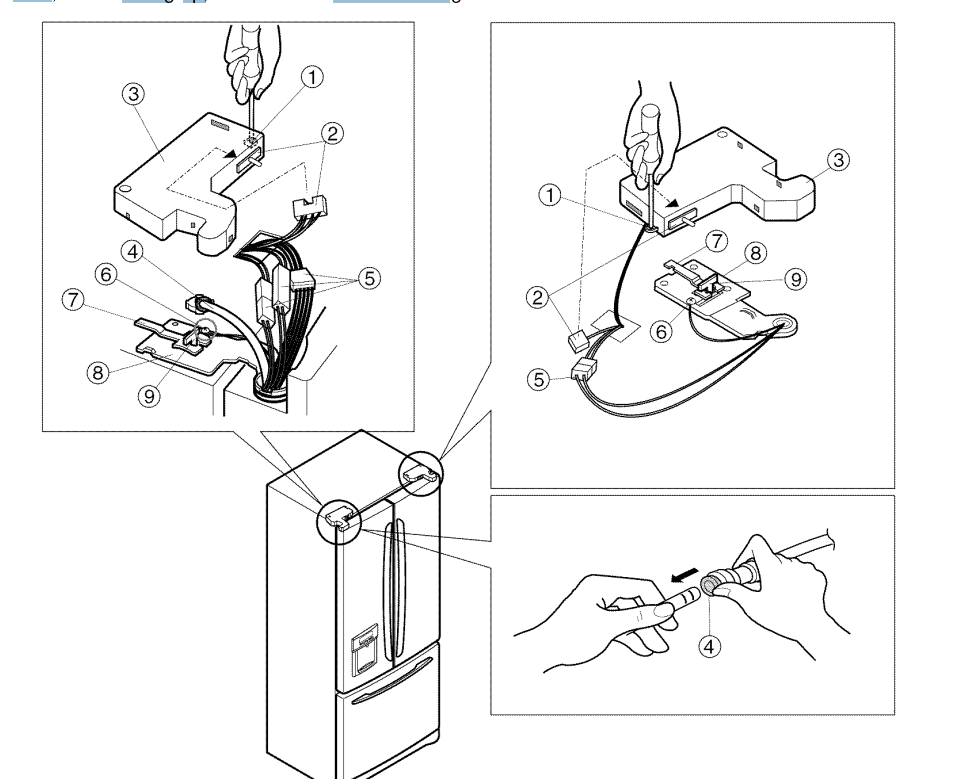
ENSURING PROPER AIR CIRCULATION
- In order to ensure proper temperatures, air must flow between the refrigerator and freezer sections. As shown in the illustration below, air enters at top of freezer and circulates down.
- From bottom of freezer, air is forced up to top of refrigerator. Air enters refrigerator through top vent, then circulates and exists at bottom, where it returns to freezer.
MULTI-FLOW
- Multi-Flow means powerful and effective cooling operation. This is especially noticeable when new food is placed in the refrigerator compartment.
- If water or foreign substances enter the cool air vent while cleaning, efficiency will be lowered. In addition, if gasket is damaged, efficiency may be lowered because of escaping cool air.

SETTING THE CONTROLS
- Your refrigerator has a control pad on the dispenser that lets you regulate the temperature in the freezer and refrigerator compartments.
- Initially set the REFRIGERATOR CONTROL at 37°F(3°C) and the FREEZER CONTROL at 0°F(-18°C). Leave it at this setting for 24 hours (one day) to stabilize. Then adjust the compartment temperature as desired.
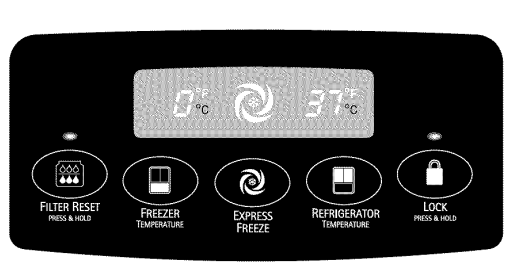
Tilt-Out Compartment
- The tilt-out compartment on the front of the crisper is for items stored best in low humidity such as apples and oranges.
- The front of the compartment is transparent to allow you to see compartment contents. Push the button on the front of the compartment to open it.
CRISPER HUMIDITY CONTROL
- You can control the amount of humidity in the moisturesealed crispers.
- Adjust the control to any setting between and v_ . keeps moist air in the crisper for best storage of fresh, leafy vegetables. v _ lets moist air out of the crisper for best storage of fruits.
To remove tilt-out compartment:
- Pull crisper drawer out to the stop.
- Open the compartment.
- Grasp side of drawer and pull outward to release tab at compartment base. Pull compartment toward you to remove.
- To replace compartment, insert compartment base tab into one side of drawer. Pull slightly outward on opposite side of drawer to insert other base tab.
GLIDE N SERVE
- The Glide N Serve provides storage space with a variable temperature control that keeps the compartment colder than refrigerator temperature.
- The drawer also features a selfopening lid that opens whenever the drawer is pulled open. This drawer can be used for large party trays, deli items, or beverages.
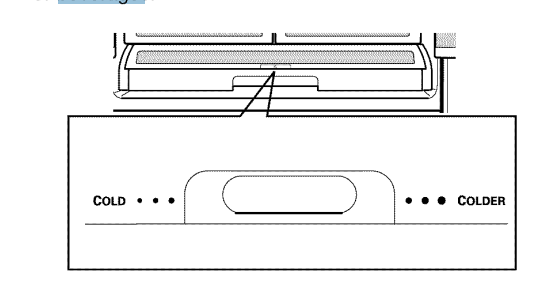
CONDENSER COILS
- Remove base cover. (See the base cover section on page 13.)
- Use a vacuum cleaner with an extended attachment to clean condenser coils.
- Vacuum coils when dusty or dirty. Coils may need to be cleaned as often as every other month.
- Replace base cover.
GENERAL CLEANING TIPS
- Unplug refrigerator or disconnect power.
- Remove all removable parts, such as shelves, crispers, etc. Refer to sections in Using Your
- Refrigerator for removal instructions.
- Use a clean sponge or soft cloth and a mild detergent in warm water. Do not use abrasive or harsh cleaners.
- Hand wash, rinse and dry all surfaces thoroughly.
- Plug in refrigerator or reconnect power.
OUTSIDE
- Waxing external painted metal surfaces helps provide rust protection. Do not wax plastic parts. Wax painted metal surfaces at least twice a year using appliance wax (or auto paste wax). Apply wax with a clean, soft cloth.
- For products with a stainless steel exterior, use a clean sponge or soft cloth and a mild detergent in warm water.
- Do not use abrasive or harsh cleaners. Dry thoroughly with a soft cloth.
CONDENSER COILS
- Remove base cover. (See the base cover section on page 13.)
- Use a vacuum cleaner with an extended attachment to clean condenser coils.
- Vacuum coils when dusty or dirty. Coils may need to be cleaned as often as every other month.
- Replace base cover.
LIGHT BULB REPLACEMENT
- Electrical Shock Hazard
- Before replacing a burned-out light bulb, either unplug the refrigerator or turn off power at the circuit breaker or fuse box.
NOTE:
- Moving the control to the OFF position does not remove power to the light circuit.
NOTE:
- Not all appliance bulbs will fit your refrigerator. Be sure to replace the bulb with one of the same size, shape and wattage.
To change Refrigerator Light Bulbs:
- Unplug Refrigerator, or disconnect power at the circuit breaker.
- If necessary, remove top shelf or shelves.
- Using a flat instrument, gently pry the lamp cover loose in the front as shown. Rotate downward to remove rear tabs.
- Make sure the bulbs are cool to the touch.
- Turn bulbs counterclockwise to remove. Insert new bulb(s).
- Assemble in reverse order by snapping the Lamp Cover in, engaging the rear tabs followed by the front tabs.
INSIDE WALLS (allow freezer to warm up so cloth won't stick)
- To help remove odors, you can wash the inside of the refrigerator with a mixture of baking soda and warm water.
- Mix 2 tablespoons baking soda to 1 quart of water (26 g soda to 1 liter water.) Be sure the baking soda is completely dissolved so does it not scratch the surfaces of the refrigerator.
WHEN YOU GO ON VACATION
- If you choose to leave the refrigerator on while you are away, follow these steps to prepare your refrigerator before you leave.
- Use up any perishables and freeze other items.
- Empty the ice bin.
- If you choose to turn the refrigerator off before you leave, follow these steps.
- Remove all food from the refrigerator.
- Depending on your model, set the thermostat control refrigerator control) to OFR See the Setting the
- Controls section.
- Clean refrigerator, wipe it and dry well.
- Tape rubber or wood blocks to the tops of both doors to prop them open far enough for air to get in. This stops odor and mold from building up.
WHEN YOU MOVE
- When you are moving your refrigerator to a new home, follow these steps to prepare it for the move.
- Remove all food from the refrigerator and pack all frozen food in dry ice.
- Depending on your model, turn the thermostat control refrigerator control) to OFF. See the Setting the
- Controls section.
- Unplug the refrigerator.
- Clean, wipe and dry thoroughly.
- Take out all removable parts, wrap them well and tape them together so they don't shift and rattle during the move. Refer to sections in Using your Refrigerator for removable instructions.
- Depending on the model, raise the front of the refrigerator so it rolls more easily OR screw in the leveling legs all the way so they don't scrape the floor.
See the Door Closing section.
- Tape the doors shut and tape the power cord to the refrigerator cabinet.
- When you get to your new home, put everything back and refer to the Installing Your Refrigerator section for preparation instructions.
To change freezer light:
1.Unplugrefrigeratorpowercordformoutlet.
2.Pulllightbulbcoverdownto remove.
3. Removeoldbulb.Replacewith60-wattappliancebulb.
4. Inserttabsonbackofcoverintoslotsinfreezerceiling. Pushcoveruptosnapfrontintoplace

OPERATION INSTRUCTIONS

- The icemaker will produce eight cubes per cycle-- approximately 100-130 cubes in a 24-hour period, depending on freezer compartment temperature, room temperature, number of door openings and other operating conditions.
- If the refrigerator is used before the water connection is made to the icemaker, set the power switch to O (off). When the refrigerator has been connected to the water supply, set the power switch to I (on). The icemaker will fill with water when it cools to freezing.
- A newly-installed refrigerator may take 12 to 24 hours to begin making ice cubes. Throw away the first few batches of ice to allow the water line to clear.
- Be sure nothing interferes with the sweep of the feeler arm. When the bin fills to the level of the feeler arm, the icemaker will stop producing ice. It is normal for several cubes to be stuck together. If ice is not used frequently, old ice cubes will become cloudy, taste stale, and shrink.
NORMAL SOUNDSYOU MAY HEAR
- The icemaker water valve will buzz as the icemaker fills with water. If the power switch is in the I (on) position, it will buzz even if it has not yet been hooked up to water.
- To stop the buzzing, move the power switch to O (off).
NOTE:
- Keeping the power switch in the I (on) position before the water line is connected can damage the icemaker.
- You will hear the sound of cubes dropping into the bin and water running in the pipes as the icemaker refills.
PREPARING FOR VACATION
- Set the icemaker power switch to O (off) and shut off the water supply to the refrigerator.
- If the ambient temperature will drop below freezing, have a qualified servicer drain the water supply system to prevent serious property damage due to flooding from ruptured water lines or connections.
BEFORE YOU BEGIN
- This water line installation is not warranted by the refrigerator or icemaker manufacturer. Follow these instructions carefully to minimize the risk of expensive water damage.
- Water hammer (water banging in the pipes) in house plumbing can cause damage to refrigerator parts and lead to water leakage or flooding.
- Call a qualified plumber to correct water hammer before installing the water supply line to the refrigerator. To prevent burns and product damage, do not hook up the water line to the hot water line.
- If you use your refrigerator before connecting the water line, make sure the icemaker power switch is in the O (off) position. Do not install the icemaker tubing in areas where temperatures fall below freezing.
- When using any electrical device (such as a power drill) during installation, be sure the device is doubleinsulated or grounded in a manner to prevent the hazard of electric shock, or is battery-powered. All installations must be in accordance with local plumbing code requirements.
TROUBLESHOOTING GUIDE
UNDERSTANDING SOUNDS YOU MAY HEAR *
- The defrost timer will click when the automatic defrost cycle begins and ends. The thermostat control (or
- Your new refrigerator may make sounds that your old one refrigerator control. depending on the model) will also didn’t make.
- Because the sounds are new to you. you click when cycling on and off. might be concerned about them. Most of the new sounds are normal.
- Hard surfaces. like the floor. walls and « Rattling noises may come from the flow of refrigerant. the cabinets. can make the sounds seem louder than they water line. or items stored on top of the refrigerator. actually are. The following describes the kinds of sounds * Your refrigerator is designed to run more efficiently and what may be making them. to keep your food items at the desired temperature.
- The high efficiency compressor may cause your new refrigerator to run longer than your old one. and you may hear a pulsating or high-pitched sound.
+ You may hear the evaporator fan motor circulating the air through the refrigerator and freezer compartments.
+ As each cycle ends. you may hear a gurgling sound due to the refrigerant flowing in your refrigerator.
+ Contraction and expansion of the inside walls may cause a popping noise.
+ Water dripping on the defrost heater during a defrost cycle may cause a sizzling sound.
+ You may hear air being forced over the condenser by the condenser fan.
+ You may hear water running into the drain pan during the defrost cycle.
The refrigerator that was replaced was an older model.
Modern refrigerators with more storage space require more operating time.
The room temperature is hotter than normal.
- The motor will run longer under warm conditions. At normal room temperatures. expect your motor to run about 40% to 80% of the time. Under warmer conditions. expect it to run even more often.
The door is opened often or a large amount of food has just been added.
- Adding food and opening the door warms the refrigerator.
- It is normal for the refrigerator to run longer in order to cool the refrigerator back down. Adding a large amount of food warms the refrigerator.
- See the Food Storage Guide section on page 15. In order to conserve energy. try to get everything you need out of the refrigerator at once. keep food organized so it is easy to find and close the door as soon as the food is removed.
The refrigerator was recently plugged in and the refrigerator control was set correctly.
- The refrigerator will take up to 24 hours to cool completely.
The refrigerator control is not set correctly for the surrounding conditions.
- See the Adjusting Control Settings section on page 15.
The doors are not closed completely.
- Push the doors firmly shut. If they will not shut all the way. see
Doors will not close completely below.
- The condenser coils are dirty.
- This prevents air transfer and makes the motor work harder.
Clean the condenser coils. Refer to the Care and Cleaning section on pages 24-25.
See other models: 79572059113 79579433211 25375088300 23352052003 10656666500
